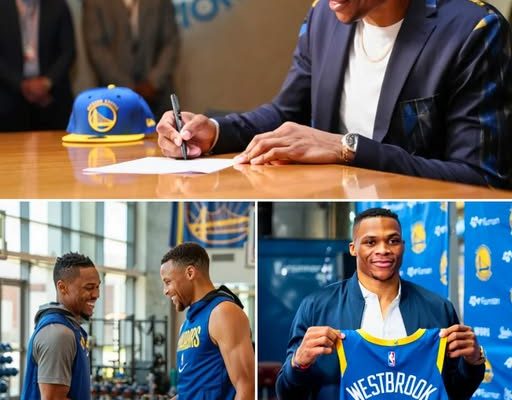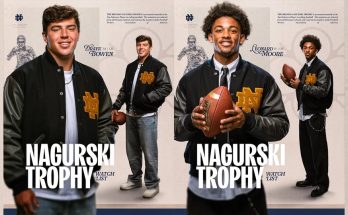When news broke that the Golden State Warriors had signed a former league MVP on a one-year veteran minimum deal, the NBA world did what it always does—it exploded. But this time, it wasn’t just the usual flurry of Twitter takes and hot-shot podcast commentary. This time, the reaction was rooted in genuine disbelief. Because the MVP in question wasn’t just any former superstar. He was someone long considered a nemesis to the very foundation the Warriors were built upon. He was a man who had stood opposite Stephen Curry in playoff wars, who had stared down the dynasty and dared to challenge its dominance. Now, he’s wearing the same jersey. And the kicker? Reports say Steph Curry wanted this.
The deal, described by insiders as “quiet but deliberate,” materialized over several weeks. Conversations happened in hotel suites, in practice facilities with locked doors, over late-night phone calls. The Warriors front office played it close to the vest, aware of how volatile the reaction might be from fans, media, and even their own locker room. But when the ink dried, the signature on the dotted line belonged to one of the game’s most polarizing figures—a player who once symbolized everything Golden State wasn’t. And now, here he is, set to join Steph, Klay, and Draymond in what could be either a storybook resurrection or a disaster waiting to unfold.
There are two ways to look at this. One perspective says it’s a panic move. The Warriors have faced back-to-back early exits from the playoffs. Klay Thompson’s departure marked the end of an era. The youth movement hasn’t progressed the way the franchise hoped. Jonathan Kuminga and Moses Moody have shown flashes, but inconsistency has plagued them. The Jordan Poole experiment, once full of promise, ended in chaos. The team’s once-pristine cap sheet has ballooned, and their place atop the Western Conference power rankings is now a distant memory. Desperate times call for desperate measures, and this signing reeks of that desperation.
But the other perspective—the one that perhaps Steph Curry himself sees—suggests something more profound. Maybe this isn’t about panic at all. Maybe this is about redemption. About legacy. About Steph Curry stepping into a role bigger than just a franchise cornerstone. About him becoming the final architect of the team’s twilight run, handpicking the very pieces that could allow Golden State to squeeze one more magical year out of its core. If Curry truly gave this move his blessing, as reports suggest, then it’s more than just a transaction—it’s a message. He’s not done yet. And he believes this former MVP still has enough left to help him write one more chapter.
Of course, the real intrigue lies in the identity of the player himself. For the sake of speculation, let’s imagine the kind of figure who fits this mold. Think of someone who once went toe-to-toe with Curry in the playoffs. Someone who challenged the Warriors’ supremacy, perhaps even carried the burden of trying to dethrone them. Someone who was once hailed as the future of the league, a dominant force capable of dragging any team into contention. And someone whose career has since been marked by turbulence—injuries, locker room drama, and the gradual erosion of athleticism that every player must eventually face. The kind of player whose story arc begs for a final act of redemption.
In many ways, this signing feels like déjà vu. It calls back to 2016, when Kevin Durant stunned the basketball world by joining a 73-win team he’d just come within inches of defeating. That move was met with outrage and admiration in equal measure. It produced championships, yes—but also complicated legacies. Durant’s decision redefined the modern superstar era, placing power squarely in the hands of players willing to link arms in pursuit of greatness. This current move may not have the same seismic implications, but it echoes that same spirit. It’s a gamble on talent, chemistry, and timing. And it’s unfolding under the microscope of a fan base that’s tasted glory—and is terrified of watching it slip away.
The Warriors now face an impossible balancing act. Integrating a former rival into an aging core while developing young talent and competing in a loaded Western Conference is no small task. The new addition will have to accept a reduced role, something that’s often easier said than done for former stars used to being the focal point. Will he buy into the Warriors’ motion offense, their culture of unselfishness, their demand for two-way effort? Will he clash with Draymond Green, the emotional heartbeat of the team, who famously doesn’t shy away from confrontation? Will he thrive off the ball next to Curry, or will old habits resurface when things get tight?
These are the questions that keep general managers up at night. But here’s the thing about Golden State—they’ve been here before. They’ve made bold bets. They’ve taken chances on personalities and talent and stitched it all together with a culture built around trust, accountability, and the generational greatness of Stephen Curry. If there’s any team that can absorb a volatile element and turn it into something powerful, it’s this one. And if there’s any player who can unify that element into a winning formula, it’s Steph.
Still, the stakes are enormous. The Warriors can’t afford another misfire. The Western Conference isn’t waiting around for them to figure it out. Denver is still formidable. Dallas has retooled. Oklahoma City is surging. The Lakers remain dangerous with LeBron and AD, and the Timberwolves are quietly one of the most complete rosters in the league. There’s no margin for error. This signing has to work. It can’t just be a feel-good story about former rivals burying the hatchet. It has to translate into wins—playoff wins. Championships, even.
And then there’s the narrative. In the modern NBA, the storylines often matter just as much as the basketball. Every press conference, every tweet, every viral highlight contributes to the legend—or the downfall—of a team’s legacy. This pairing of Steph Curry and his one-time foe will be dissected endlessly. Every missed shot will be ammunition for the skeptics. Every on-court argument will be framed as proof that “it was never going to work.” But on the flip side, every moment of chemistry, every clutch performance, every hand-slap or embrace will feed the dreamers. The believers. Those who still think sports can deliver the kind of unlikely, redemptive arcs that feel more like Hollywood scripts than real life.
For Steph Curry, this might be the most personal bet of his career. He’s always been the underdog who shattered expectations. Now he’s the established legend trying to extend his reign, even if it means trusting a man he once tried so hard to defeat. It’s a full-circle moment. And those don’t come around often.
As training camp approaches, all eyes will be on the Bay Area. Not just because of what this move means on paper, but because of what it says about the Warriors’ future. About the fragility of dynasties. About the desperation to stay relevant in a league that evolves by the second. And most of all, about the power of belief. Belief that two former rivals can become teammates. That past animosities can become future partnerships. That one more ring isn’t just a fantasy—but a real, tangible goal.
No matter how it plays out, this will be a season to remember. Whether it ends in banners or broken dreams, the Warriors have once again given the NBA its most compelling storyline. And for that alone, it was worth the risk.



